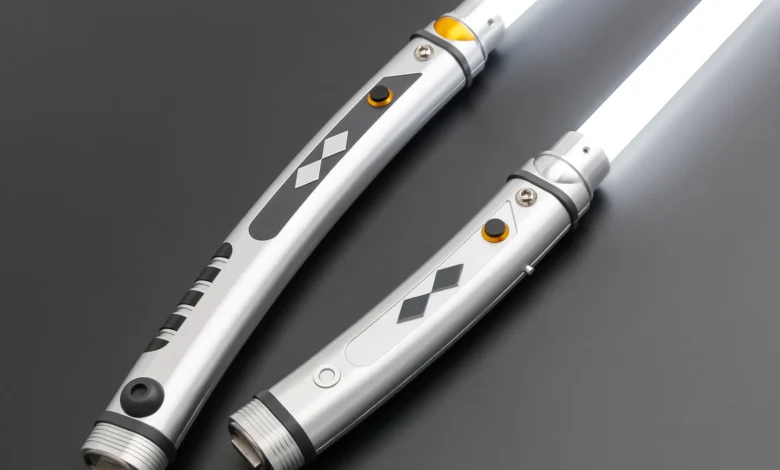The Complete Evolution of Ahsoka Tano’s Lightsaber from Padawan to Rebel

When Ahsoka Tano ignited her lightsabers for the first time in Star Wars: The Clone Wars, fans witnessed the beginning of something special. This young Togruta would become one of the most beloved characters in the franchise, and her weapons tell a story that mirrors her growth from an eager student to a seasoned warrior fighting for justice across the galaxy.
The Ahsoka Tano lightsaber collection represents more than just elegant weapons. Each blade she’s wielded marks a distinct chapter in her life, reflecting her evolving philosophy, combat style, and place in the larger Star Wars universe. From green blades to blue, and eventually to her iconic white sabers, Ahsoka’s weapons have become as recognizable as the character herself.
The Padawan Years: Green and Yellow-Green Blades
Ahsoka’s first lightsaber appeared when she was just a young Padawan learning under Anakin Skywalker. Her initial weapon featured a green blade, traditional for Jedi Consulars and those who preferred negotiation and wisdom. However, Ahsoka’s aggressive fighting style and natural talent soon required something more.
As she developed her unique combat approach, Ahsoka adopted a dual-wielding technique that set her apart from other Jedi. Her primary Ahsoka Tano lightsaber maintained its green color, while she constructed a shorter shoto blade with a yellow-green hue. This secondary weapon gave her a significant advantage in close-quarters combat and allowed her to execute the defensive Jar’Kai form with exceptional skill.
Why the Dual-Blade Approach Worked
The shoto blade became her signature, and the combination offered several tactical advantages:
- Enhanced defensive capabilities by covering more attack angles simultaneously
- Increased unpredictability in combat situations against single-blade opponents
- Better adaptation to her smaller stature and acrobatic fighting preferences
- Improved ability to engage multiple enemies at once
This combination demonstrated her creativity and willingness to break from traditional Jedi training methods.
Transition to Blue: A New Identity Takes Shape
Following the loss of her original weapons, Ahsoka constructed new lightsabers that featured blue blades. This color shift coincided with her maturing as both a warrior and a person. The blue blades suggested a move toward the Jedi Guardian path, emphasizing combat prowess and protection of the innocent.
Ahsoka Tano’s lightsabers during this period featured refined designs with curved hilts that better suited her acrobatic fighting style. The handles incorporated elements that reflected her Togruta heritage while maintaining the elegant functionality required for her dual-wielding technique. These weapons saw her through some of the most challenging battles of the Clone Wars.
Design Elements That Made Them Unique
The blue-bladed sabers included several distinctive features:
- Curved hilts that allowed for better grip during reverse-hand techniques
- Lightweight construction enables faster strikes and aerial maneuvers
- Modified activation switches positioned for quick ignition during combat
Her proficiency with these weapons grew to the point where she could face multiple opponents simultaneously, deflect blaster fire from various angles, and even hold her own against formidable adversaries like General Grievous and Asajj Ventress.
The White Lightsabers: Purification and Independence
The Ahsoka Tano white lightsaber represents perhaps the most significant transformation in her journey. After leaving the Jedi Order and experiencing profound loss, Ahsoka found herself without her traditional weapons. When she eventually constructed new lightsabers, she made a choice that no Jedi or Sith had made before.
Rather than choosing a color associated with either the light or dark side, Ahsoka purified corrupted kyber crystals she obtained from an Inquisitor. This purification process stripped the crystals of their synthetic red coloring, resulting in brilliant white blades. The symbolism couldn’t be clearer—Ahsoka stood apart from both Jedi and Sith, walking her own path guided by the Force.
The Process Behind the White Blades
Creating the white lightsabers involved several crucial steps. Ahsoka had to defeat the Sixth Brother, an Imperial Inquisitor, and claim his lightsaber. She then carefully extracted the corrupted kyber crystals, which had been synthetic creations imbued with dark side energy. Through meditation and connection with the Force, she healed these crystals, removing the corruption and leaving them colorless—manifesting as white when activated.
The resulting Ahsoka Tano white lightsaber design featured sleeker, more refined hilts than her previous versions. The white blades became her trademark during her time with the Rebel Alliance, representing her role as neither Jedi nor Sith but as something new entirely.
Combat Evolution: From Student to Master
Ahsoka Tano, with a lightsaber in comba,t showcased different styles throughout her development. As a Padawan, she relied heavily on aggression and speed, often taking risks that more experienced Jedi would avoid. Her dual-wielding technique compensated for her smaller size and allowed her to overwhelm opponents with rapid strikes from multiple angles.
Her reverse-grip style, where she held her main lightsaber backward along her forearm, became her signature move. This unorthodox approach confused enemies and created unexpected attack patterns. Combined with her shoto blade in a traditional grip, she could seamlessly transition between offensive and defensive positions.
Signature Techniques and Moves
By the time she wielded her white lightsabers, Ahsoka had refined her combat style into something truly unique:
- Dual-wielding coordination that allowed simultaneous blocking and striking
- Acrobatic maneuvers incorporating Togruta agility and Force-enhanced jumps
- Defensive mastery capable of deflecting sustained blaster fire from multiple directions
Her skills had grown to where she could face Darth Vader himself, demonstrating that she’d evolved beyond what any traditional Jedi training could have produced.
The Rebel Era: Tools of a Freedom Fighter
During her involvement with the Rebel Alliance, Ahsoka Tano’s lightsabers took on new meaning. They weren’t just weapons of a Jedi or tools of the Force—they represented hope for those fighting against Imperial oppression. Her white blades became symbols of resistance, proof that someone with power and skill stood with the rebellion.
What the White Blades Represented to the Rebellion
Ahsoka used her Ahsoka Tano lightsabers sparingly during this period, understanding that revealing herself as a Force user could bring unwanted attention. The white lightsabers carried deeper significance for those who knew their story:
- Proof that redemption and purification were possible even for corrupted objects
- A symbol of independence from both Jedi dogma and Sith corruption
- Visual confirmation that powerful allies supported the Rebel cause
- Hope that the Force could still be used for good outside the old institutions
When she did ignite them, it was always at critical moments where her intervention could turn the tide of battle.
Technical Specifications Across All Versions
Throughout her life, Ahsoka Tano, with lightsaber weapons, showed a consistent design philosophy despite their different appearances. Her primary blade typically measured between 90-95 centimeters in length, while her shoto remained around 60-65 centimeters. This size difference remained constant whether her blades glowed green, blue, or white.
The hilts evolved from simple Padawan designs to more sophisticated constructions that reflected her growing expertise. Her white lightsaber hilts featured clean lines and ergonomic grips, stripped of unnecessary ornamentation but perfectly balanced for her fighting style.
Key Design Features
The evolution of Ahsoka Tano with lightsaber technology included:
- Progressive refinement of hilt ergonomics for improved control
- Weight distribution optimized for dual-wielding and reverse-grip techniques
- Activation mechanisms positioned for her specific fighting patterns
Legacy and Impact
The Ahsoka Tano white lightsaber has become one of the most recognizable weapons in Star Wars canon. Unlike the binary choice between Jedi blue and green or Sith red, Ahsoka’s white blades opened new possibilities for Force users who rejected traditional boundaries.
Her weapon evolution mirrors her character development perfectly. She started with traditional Jedi colors, representing her training and beliefs as a young Padawan. The transition to blue marked her growth and increasing independence. Finally, the white blades symbolized her complete transformation into someone who transcended old categories and definitions.
For fans and aspiring Jedi alike, Ahsoka Tano’s lightsabers represent the possibility of forging your own path while staying true to the core values of justice and compassion. They remind us that sometimes the most powerful choice is to stand apart from established systems while fighting for what’s right.




